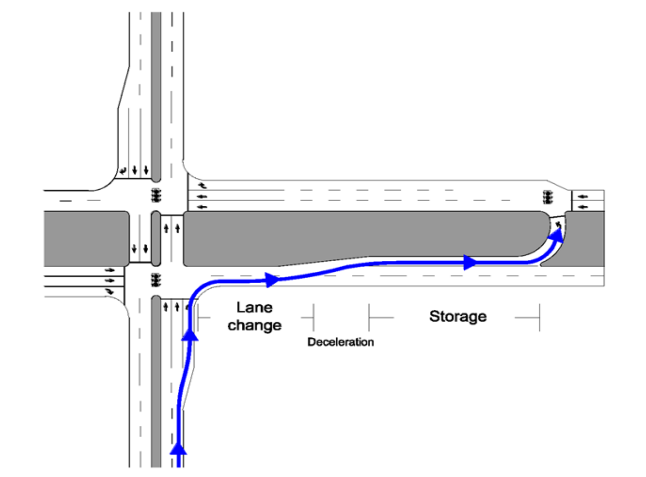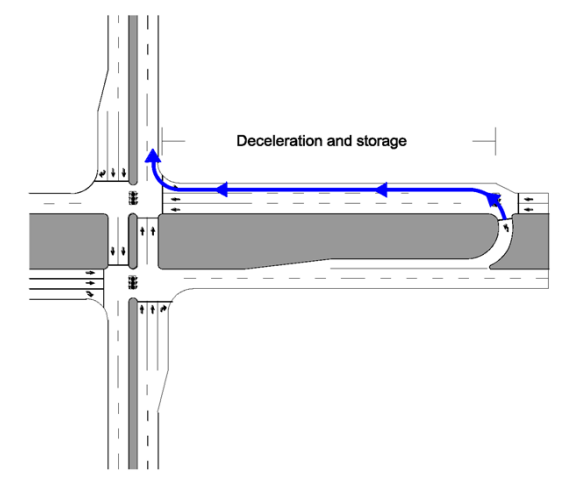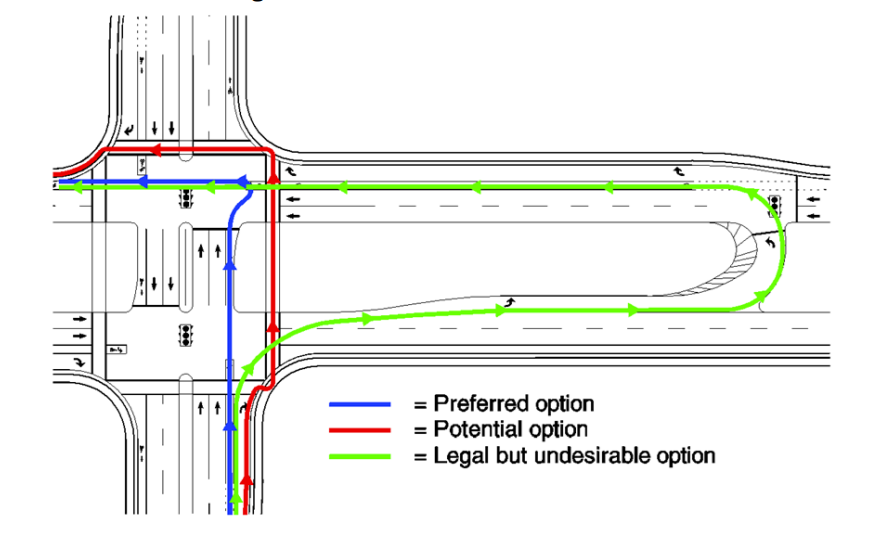14.8 Median U-Turn Intersection (MUT)
14.8.1 Overview
A Median U-Turn (MUT) or “Michigan Left” intersection replaces direct left-turns at an intersection with indirect left-turns using a U-turn movement in a wide median. The MUT intersection eliminates left-turns on both intersecting streets, thus reducing the number of traffic signal phases and conflict points at the main crossing intersection, which results in improved intersection operations and safety.
TxDOT has adopted the
as the primary source for MUT Guidelines. The information contained in this section is considered a companion guide and is intended to document TxDOT’s suggested approach to MUT design. See
for an example MUT configuration.

Figure 14-31: Example of a MUT Intersection With One Signal in Main Intersection
Source: Virginia DOT, used by permission
Documented benefits of a MUT include:
- Removal of left-turn signal phasing which allows the intersection to operate well with a shorter cycle length;
- Reduction of intersection conflict points for both vehicles and pedestrians; and
- General increase in safety performance.
Conditions where a MUT may not be suitable include:
- High traffic volumes –the addition of U-turn movements can cause spillback into the through lanes and increase congestion;
- Narrow medians –this can make it difficult for larger vehicles to maneuver the U-turn and may require turning loons; and
- Inadequate driver familiarity –if drivers do not understand how to navigate the intersection it may result in crashes.
14.8.2 Design Considerations
The distance between the MUT crossovers is central to the proper functioning of the intersection. The AASHTO recommended spacing from the main intersection to the median opening is 400-ft to 600-ft, although this distance may be modified per guidance in the
. Longer distances are preferred for weaving, but as the distance between the intersection and median opening increases, the delay for the minor road left-turn and through vehicles increases. See
through
for spacing considerations.

Figure 14-32: Spacing Consideration for a Major Street Left-Turn Movement
Source: FHWA MUT Informational Guide

Figure 14-33: Spacing Consideration for Minor Street Left-Turn Movement
Source: FHWA MUT Informational Guide

Figure 14-34: Spacing consideration for a Right-turn
Source: FHWA MUT Informational Guide
The MUT median width is a function of the design vehicle (typically a WB-62TX or WB-67) and the preferred alignment of the design vehicle as it turns into the opposing traffic. See
discussion on Median U-Turn Movements and minimum median width needed. For instances where the U-turn can’t be completed, a loon may be used to provide additional space. See
as an example application for a longer weaving distance.
14.8.3 Pedestrian and Bicyclist Considerations
MUTs have benefits for pedestrians which include a reduction in the number of conflict points and benefits due to two-phase signalization. Pedestrian crossings may be either single-stage (walk signal is timed to allow crossing the entire roadway on a single walk indication) or two-stage (a separate walk signal is used to cross each direction of a divided roadway).
Additional pedestrian crossings may be installed at U-turn crossover locations. With vehicular left-turn lanes removed from the crossing locations, the lengths of crossings for pedestrians can often be reduced compared to a conventional intersection.

Figure 14-35: Pedestrian Crossings at U-turn Crossover Location
Source: NCHRP Report 948 for Pedestrian and Bicycle Safety at Alternative and
Other Intersection and Interchanges
Bicyclists have three options for navigating a MUT intersection when making a left-turn:
- Bicyclists making a two-stage left-turn (preferred option):Minor street bicyclists approach the intersection on the right and follow the vehicle signal indications. When receiving the green indication, the bicyclists proceed across the intersection and stop in a bicycle turn queue box. When the major street receives a green indication, bicyclists proceed along the major street.
- Bicyclists follow pedestrian crossing rules (potential option):Bicyclists approach the intersection and exit the street to the right and follow the pedestrian (“walk”/”don’t walk”) indications.
- Bicyclists following vehicle rules (legal but undesirable option):Bicyclists approach the intersection on the right and follow the vehicle signal indications. This option is legally permissible, but undesirable.
Ultimately, a thorough site assessment, an assessment of anticipated bicycle and pedestrian volumes, and an assessment of projected origins and destinations for pedestrians and bicyclists should be conducted to determine the preferred method of movement through the MUT.
shows the three bicyclist options.

Figure 14-36: Left-Turn Options for Bicycles
Source: FHWA MUT Informational Guide
14.8.4 Access Management
From an access management standpoint, possible advantages of a MUT include the elimination of left-turns from driveways and the consolidation of access to U-turn crossover intersections. Possible disadvantages include having to pass twice through intersections, and restricted access between main crossing and U-turn intersections. Refer to the
for additional guidance with respect to access management.
Additionally, corridor wide access strategies and management considerations to properties along the major street should be considered to promote safe and efficient access to these properties. Refer to
.
14.8.5 Safety
MUT intersections have safety benefits due to reduced conflict points, especially crossing conflict points, resulting in fewer severe crashes. Potential safety issues to consider at median U-turn intersections include:
- Conflicts where U-turns are aligned with driveways or streets that only permit right-turns;
- The need for channelization to prevent wrong-way movements; and
- The potential for weaving movements on the major street.
For additional information on safety refer to the
.
14.8.6 Operations
The MUT intersection provides operational benefits, especially for the through movement on the major street. Signal timing and phasing for the MUT and corridor are critical to the operational performance of MUT intersections. Refer to the
for further operational considerations.
14.8.7 Traffic Control Devices
MUT intersections require clear traffic control devices to guide drivers through the intersection. The four main objectives of traffic control devices in MUT intersections are:
- Provide signage and pavement markings to prohibit left-turns and alternative routing of left-turn movements;
- Provide one-way and wrong-way signage;
- Provide a means for direct or indirect bicycle left-turn movements; and
- Provide appropriate safety lighting at conflict points.
Refer to the
for further guidance on traffic control devices. The TMUTCD remains the primary source for traffic control device standards.